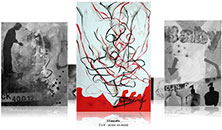I can't exactly put my finger on why, but these new station identification advertisements from Nickelodeon definitely amuse me. I find the organic shapes created by the flying slime, the timing, and the erratic adjustments in motion very successful!
And it is painless to watch them when they are inevitably shown again and again. So I have to ask why? Most ads annoy me enough to make me change the channel. Either I'm easily amused at the moment or there is some genius juxtaposition happening here that is grabbing my attention.
Maybe the overall success has something to do with the contrasting elements: the way the shiny, heavy, opaque slime slams against the clean, alert, bright faces of Nic's current TV stars.
The repetition of phonics in the audio also helps the success in entirety.
Funny thing is... the actors know the slime is coming... yet they open their mouths and smile — great additional components! The white background of the scenes echo the clean/dirty contrast too. I'm curious how many takes it took to complete the ads?
Whatever the answer, simple or not, the fact is that these are really well done advertisements for the station. Very memorable, maybe even nostalgic; back to the original days of getting slimmed on Double Dare (side-note: Marc Summers, host of Double Dare had OCD).
Well done Nickelodeon! And it looks like you all had fun creating these ads.
